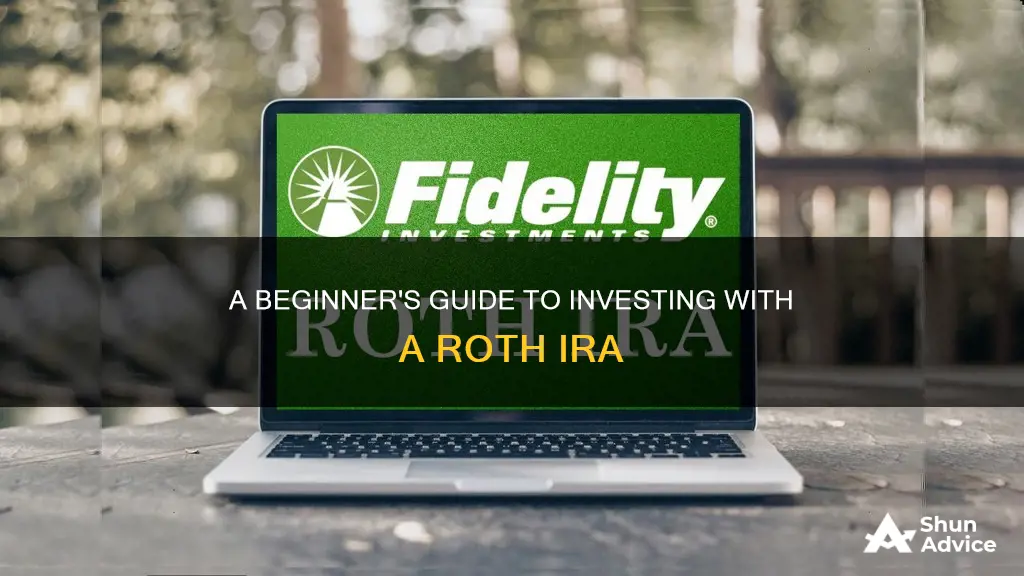
A Roth IRA is a powerful way to save for retirement. It is an individual retirement account that you fund with after-tax dollars. Your investments have the potential to grow tax-free and may be withdrawn tax-free, provided certain requirements are met. There are no account-opening fees or minimums and you can invest with as little as $1. You can contribute up to $7,000 for 2024 and once you reach the age of 50, contribution limits increase by $1,000.
When choosing investments, think about how comfortable you are with risk. Make sure that the amount of any stocks, bonds, and short-term securities in your asset mix reflects your time frame for investing and the associated need for growth.
Fidelity offers a range of tools and resources to help you get started with your Roth IRA, including a step-by-step guide to choosing and managing your investments, and a comparison of different types of IRAs.
| Characteristics | Values |
|---|---|
| Type of account | Individual retirement account (IRA) |
| Contribution type | After-tax dollars |
| Investment options | Stocks, bonds, mutual funds, exchange-traded funds (ETFs), target date funds |
| Withdrawal rules | Tax-free and penalty-free at any time for contributions; tax-free for earnings if over 59 1/2, disabled, or deceased |
| Income requirements | Modified adjusted gross income (MAGI) and tax-filing status determine contribution limit |
| Investment tools | Fidelity Go®, Fidelity Wealth Services, online guides, free online financial planning tools |
| Account opening fees | $0 |
| Minimum investment | $1 |
What You'll Learn

Choosing stocks
When you buy a stock, you're buying a small stake in a specific company. Stocks are often the first thing people think of when they think of investing.
- Do your research: Look at the company's financials, news, and industry trends. Understand the company's business model, products, and competitive advantage.
- Understand the risk: Stocks are generally considered riskier than other investments like bonds or mutual funds. The stock market can be volatile, and stock prices can fluctuate significantly.
- Diversify your portfolio: Don't put all your money in one stock or one industry. Diversification can help manage risk and potentially improve your returns over time.
- Consider your investment horizon: If you're investing for the long term, you may be able to take on more risk than if you're investing for the short term.
- Set a price target: Decide how much you're willing to pay for a stock and stick to it. This can help you avoid overpaying or buying at the wrong time.
- Start small: If you're new to stock investing, consider starting with a small amount of money and gradually increasing your investments as you gain experience and confidence.
- Monitor your investments: Regularly review your stock holdings to ensure they're performing as expected and making adjustments as needed.
Remember, investing in stocks carries a higher risk than some other investments, so it's important to do your research and understand the potential risks and rewards before investing your money.
ETFs: Your Guide to Making a Cool Half Million
You may want to see also

Using mutual funds
- Choose the right Fidelity account for you: Fidelity offers a range of accounts, including the Fidelity brokerage account for general investing and trading, and the Fidelity Roth IRA for retirement savings. You can open a new account online in just a few minutes.
- Fund your account: Once your account is open, it's time to fund it. You can easily link your bank account to your Fidelity account and transfer money anytime or set up automatic deposits.
- Choose your investments: When your money is in your account, you can start choosing your investments. Consider your risk tolerance, timeline, and investment goals when making your selections.
- Diversify your portfolio: It's important to diversify your investments to manage your risk. This means spreading your investments across different types of assets, such as stocks, bonds, and other investments.
- Monitor your investments regularly: Review your investments on a regular basis to ensure they are performing as expected and are still aligned with your investment goals and risk tolerance.
- Compare different mutual funds: When selecting a mutual fund, consider factors such as the fund's expense ratio, assets under management, performance, and holdings. You can use Fidelity's research tools to compare different funds and find the one that best suits your investment goals.
- Consider the benefits of a Roth IRA: With a Roth IRA, you contribute money that has already been taxed, and your investments can grow tax-free. This means that when you withdraw your funds in retirement, you won't have to pay any additional taxes.
- Understand the different types of mutual funds: There are various types of mutual funds available, such as target-date funds, index funds, and thematic funds. Target-date funds become more conservative as they approach a specific date, index funds mirror a particular stock or bond index, and thematic funds focus on specific areas of interest.
- Seek professional advice: If you're unsure about choosing and managing your own investments, consider seeking advice from a financial professional. Fidelity offers a range of professionally managed investment options, including accounts with $0 advisory fees and no minimum balances.
By following these steps and tips, you can effectively use mutual funds to invest in your Fidelity Roth IRA, giving you the potential for tax-free growth in your retirement savings.
Free Cash Flow: Investment Costs and Their Inclusion
You may want to see also

Understanding exchange-traded funds (ETFs)
Exchange-traded funds (ETFs) are a type of index fund that can be traded on exchanges, generally tracking a specific index. ETFs are bought and sold like common stock on a stock exchange. They are a collection of stocks, bonds, or other securities in one fund or have exposure to a single stock or bond through a single-security ETF. ETFs are a flexible and affordable way to access a wide variety of asset classes.
ETFs are considered more tax-efficient than actively managed mutual funds. They are also more cost-effective, safe, transparent, widely diversified, flexible, and liquid. ETFs are traded at any time on the stock exchange like a share. They enable you to invest cost-effectively in entire markets with one security. For example, with a single MSCI World ETF, you can spread your investment over around 1,600 companies worldwide.
ETFs are also available on most online investing platforms, retirement account provider sites, and investing apps like Robinhood, often with commission-free trading. After creating and funding a brokerage account, investors can search for ETFs and execute their chosen buys and sells.
ETFs are subject to market fluctuation and the risks of their underlying investments. They are also subject to management fees and other expenses and may trade at a discount to the net asset value (NAV).
Using Zelle With Fidelity Investments: A Comprehensive Guide
You may want to see also

Bonds and their benefits
When you buy a bond, you are effectively lending money to a company, government, or agency. In exchange, you receive regular interest payments and the promise of repayment of the principal (the amount you initially paid) at a future date. This makes bonds a great option for diversifying your investment portfolio.
Types of Bonds
There are several different types of bonds to choose from, each with its own unique characteristics and benefits:
- Treasury bonds are issued by the US Treasury to fund government activities and service the national debt. They are backed by the "full faith and credit of the US government," making them a very low-risk investment option. While the yields are generally lower than those of other bonds, the income generated is not subject to state or local taxes.
- Agency/GSE bonds are issued or backed by a US government department or agency and are thus guaranteed by the federal government.
- Municipal bonds are issued by municipalities such as states, counties, cities, or towns to fund public works projects or municipal government activities. They are usually exempt from federal income tax and state and local taxes if the bondholder lives in the issuing state.
- Corporate bonds are issued by corporations to fund equipment purchases, expansion, construction, and other projects. They typically pose a higher risk than the above three types of bonds and often have higher yields as a result.
Benefits of Bonds
Bonds offer several advantages that make them an attractive investment option:
- Regular income: Bonds provide a reliable stream of income through regular interest payments, typically made twice a year.
- Diversification: Bonds can help diversify your investment portfolio, particularly when combined with other types of investments such as stocks.
- Lower risk: Bonds tend to be lower-risk investments compared to stocks, although it's important to note that some bonds are riskier than others.
- Tax advantages: Certain types of bonds, such as government, agency, and municipal bonds, may offer tax advantages. For example, municipal bonds are often exempt from federal income tax and state and local taxes for residents of the issuing state.
- Capital preservation: Bonds can help preserve your capital, especially as you approach retirement and seek to balance growth with protection of your savings.
Things to Consider
When investing in bonds, there are several factors to keep in mind:
- Maturity date: This is the date when the bond issuer will repay the full amount you loaned them.
- Face value: Also known as "par value," this is the amount of money the bondholder will be paid on the maturity date.
- Coupon rate: The annual interest rate, expressed as a percentage, that the issuer pays to the bondholder.
- Bond credit rating: Ratings agencies assign grades to bonds based on the financial health of the issuer, which can change over time.
- Callability: Issuers may want to repay bonds early if interest rates fall, allowing them to issue new bonds at lower rates.
- Yield: The percentage of return an investor receives based on the amount invested or the current market value of their holdings.
Individual Bonds vs. Bond Funds
You can choose to invest in individual bonds or bond funds, each with its own pros and cons:
- Individual bonds offer greater control over your portfolio but require more time and financial resources for research and management. They also tend to require a larger initial investment amount.
- Bond funds provide broader diversification with a smaller investment and are professionally managed. However, they come with management fees and may offer less predictable returns due to their composition of multiple bonds with different interest rates and payment schedules.
Square Cash: A Smart Investment Strategy for Beginners
You may want to see also

The pros and cons of a Roth IRA
A Roth IRA is a powerful way to save for retirement. Here are some pros and cons to consider:
Pros
- Tax-free growth and withdrawals in retirement: Any investment growth in a Roth IRA is tax-free, and withdrawals are also tax-free, provided certain requirements are met.
- Flexible access to your money: You can withdraw your contributions at any time without taxes or penalties.
- No required minimum distributions (RMDs) during your lifetime: Unlike traditional IRAs, you are not required to withdraw money from a Roth IRA at a certain age.
- Contributions can be withdrawn at any time without penalty or taxes: This makes it a cheaper choice when your emergency fund needs access to its own emergency fund.
- Diversification in retirement: Having a mix of tax-deferred accounts and a Roth IRA can help manage your overall income tax liability in retirement.
- If you're older, you can continue to contribute as long as you work: There is no age requirement for contributions to a Roth IRA, as long as you are within the income limits.
Cons
- No upfront tax break: Contributions to a Roth IRA are made with after-tax dollars, so there is no immediate tax deduction.
- Income limits to contribute: There are income limits for contributing to a Roth IRA, and above certain incomes, your contribution may be reduced or phased out completely.
- Waiting period to withdraw earnings: You must hold the account for at least five years and be 59 1/2 or older to withdraw earnings without taxes and penalties.
- Lower contribution limits: The maximum contribution to a Roth IRA is $7,000 in 2024 and 2025 ($8,000 if age 50 and older), which is relatively low compared to a 401(k).
Fidelity Investments: Sport Clips' Financial Management Partner
You may want to see also
Frequently asked questions
Opening a Roth IRA account is a simple process and can be done online. You can compare fees and available securities at a wide range of broker-dealers or financial institutions offering Roth IRAs.
A Roth IRA is an individual retirement account that lets you save and invest post-tax dollars, and in retirement, you can make tax-free withdrawals. You can also withdraw contributions you made at any time without taxes or penalties.
It is important to do your research and understand the risk involved. You should have a mix of stocks, bonds, and other investments, and should diversify within those different types of investments.
You can fund your Roth IRA by contributing cash from your bank account, wire transfer, or ACH as an eligible yearly contribution.
You can contribute up to the lesser of 100% of your earned income or $7,000 for 2024. Once you reach age 50, contribution limits on IRAs increase by another $1,000.







